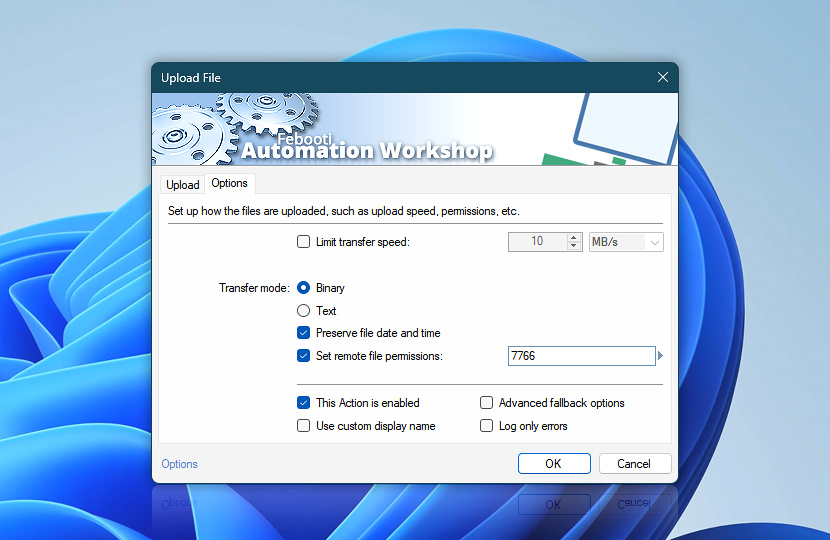Configure the uploading process when transferring files and folders from a local machine to a remote server so that it fits into the allocated bandwidth, uses the proper file transfer mode, and preserves or modifies file dates and permissions.
| Options | Details |
|---|---|
| Limit transfer speed | Set transfer speed limit for Upload File Action to reserve bandwidth for other Tasks or applications. |
| Transfer mode | Choose file transfer mode:
|
| Preserve file date and time | If enabled, uploaded files will have the same date and time as the originals. If disabled, date and time of uploaded files will be changed to current date and time. |
| Set remote file permissions | |
| Speed units | |
| Variable Wizard | |
| This Action is enabled | An Action is executed only if it is enabled. Otherwise, it will be automatically skipped (completely ignored) from the Task flow. |
| Use custom display name | Rename this Action, to make a human-readable workflow that will help you to find, read, and make sense of the Task structure later. |
| Advanced fallback options | Manage the advanced fallback options—select which error types will lead to automatic execution of predefined workaround operations. |
| Log only errors | Do not log information and warning messages for this Action. It may be useful to keep the log file small and tidy on production systems. |
Notes
- The Text transfer mode is only suitable for ASCII files that are single-byte encoded plain text files (for example,
.txt) such as UTF-8. Other encodings such as UTF-16 and UTF-32, and other text file formats such as.doc,.docx,.pdf,.rtfwill be corrupted. Always choose Binary transfer mode to keep the file unchanged. - Amazon S3 and WebDAV connections do not support ASCII text transfer mode.
- The Preserve file date and time option may depend on the server protocol, such as FTP, SFTP, and WebDAV, and also on the server operating system and software. Amazon S3 cannot preserve timestamps, while WebDAV servers rarely can.
- Google Cloud Storage and DigitalOcean Spaces use the S3 transfer protocol and thus do not support the date/time preserving options. Also, the only possible transfer option is the binary mode. Google Cloud and DigitalOcean protocols do not transfer information about directory modification timestamps.
- Many file systems support more than one file timestamp, such as created and modified. Usually, only the modified date is preserved. For example, Amazon S3 folders do not support timestamps at all.
We are here to help…
If you have any questions, please do not hesitate to contact our support team.

